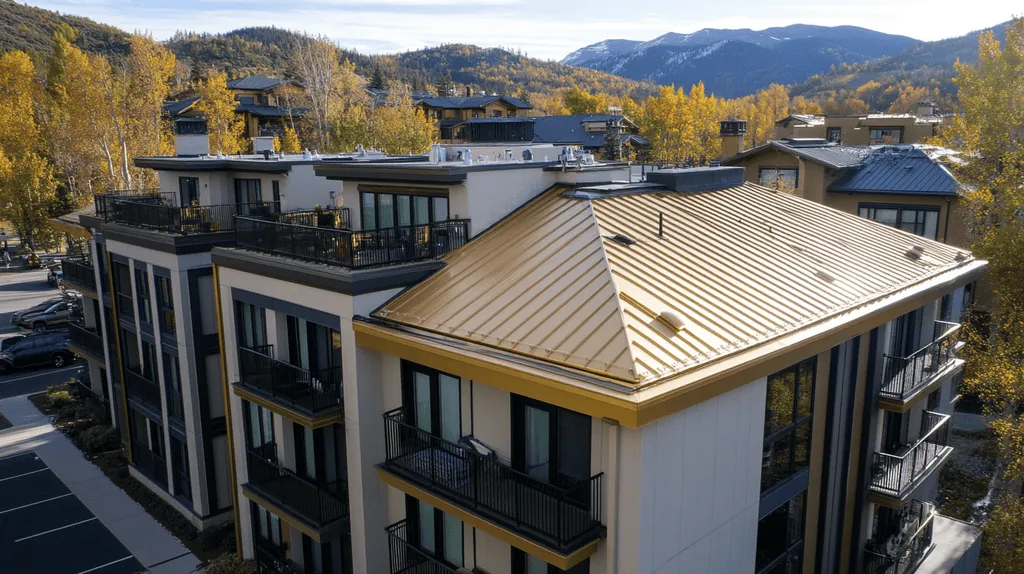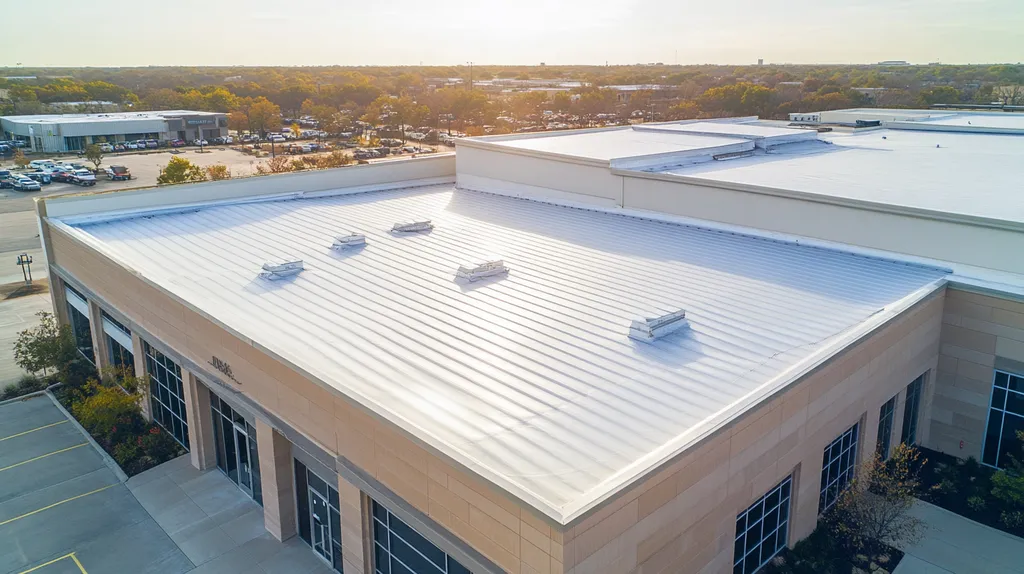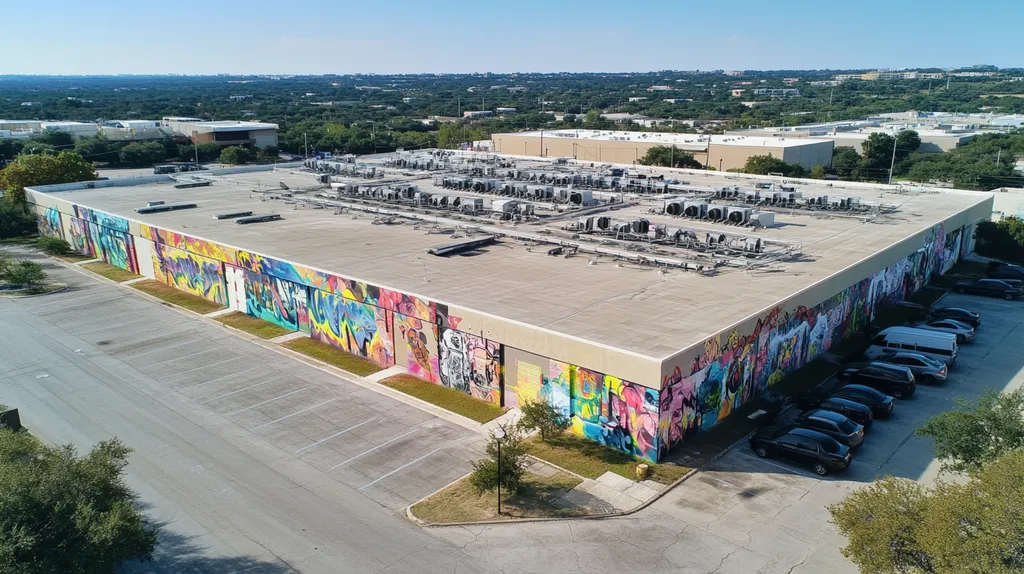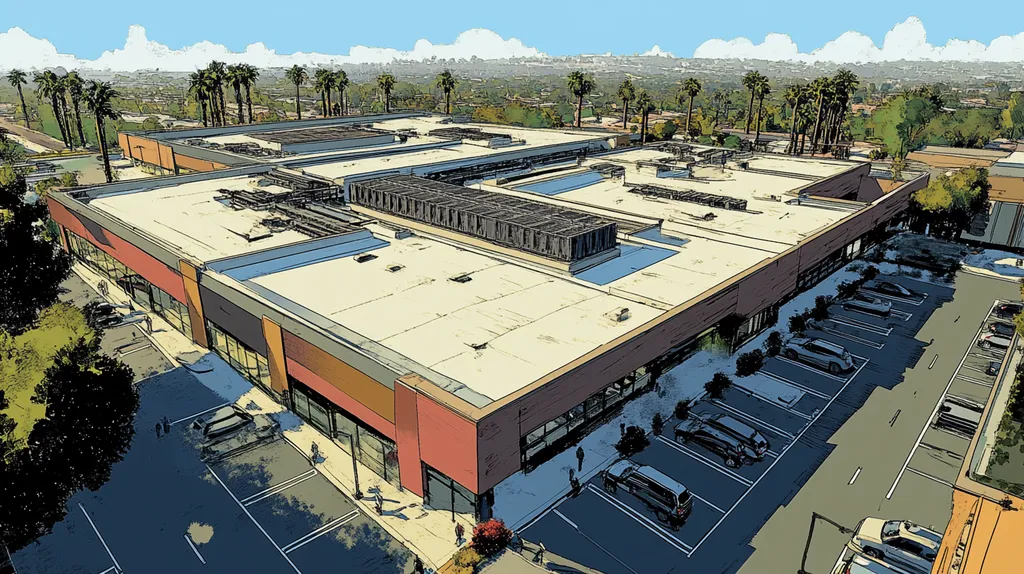Welcome to today’s Battle Royale featuring two roofing heavyweights: “Drone Inspections” in the east corner versus “Visual Inspections” in the west!
Tonight’s showdown pits these contenders against each other across six punishing rounds designed to test every aspect of their performance for Commercial Roof Damage Inspection.
At stake? Millions in potential costs, decades of building protection, and the critical performance demands of modern commercial and industrial facilities.
Our professional judging panel will evaluate each round on technical merit, real-world performance, and value delivery. After all six rounds, we’ll declare our ultimate champion.
Ladies and gentlemen, facility managers and building owners… it’s time to rumble!
ROUND 1: INITIAL COSTS & INSTALLATION
When it comes to commercial roof inspections, the financial stakes are substantial. With an average roof size of 20,000 square feet and repair costs reaching up to $15 per square foot, choosing the right inspection method becomes a critical business decision.
Let’s examine how drone inspections and traditional visual methods compare in terms of upfront investment, setup requirements, and project efficiency.
Material Expenses
Initial equipment costs vary significantly between drone and visual inspection methods. While drones require substantial upfront investment in equipment and software, these costs are typically amortized across multiple inspections.
Drone systems equipped with thermal imaging and high-resolution cameras can cost between $5,000 to $25,000. However, these systems deliver consistent, reproducible results and can inspect multiple properties efficiently.
Visual inspections require minimal equipment investment beyond basic safety gear and diagnostic tools. Yet, the labor intensity and potential for overlooked issues can result in higher long-term costs.
When considering comprehensive detection capabilities versus initial investment, drone inspections earn an “ADVANTAGE” in this category.
Installation Complexity
Infrared imaging through drone technology enables quick moisture detection without physical roof access. These systems can be deployed rapidly and scan large areas efficiently.
Visual inspections require extensive setup including safety equipment, access points, and often core sampling. This physical presence increases both complexity and risk.
The streamlined nature of drone deployment, combined with reduced safety considerations, makes the setup process significantly more straightforward. (source: Procore)
Given the simplified setup and reduced complexity, drone inspections claim another clear “ADVANTAGE.”
Project Timeline
Time efficiency directly impacts both cost and building protection. Drone inspections can typically complete a thorough roof assessment in 1-2 hours, with results available almost immediately.
These systems can inspect up to 100,000 square feet of roofing in a single day, requiring minimal disruption to building operations. The speed of data collection and analysis accelerates decision-making.
Traditional visual inspections often span multiple days, especially for larger facilities. Weather delays, physical limitations, and the need for multiple inspection points extend the timeline significantly.
With superior speed and efficiency, drone inspections secure their third “ADVANTAGE” in timeline management.
ROUND 1 WINNER: DRONE INSPECTIONS
ROUND 2: DURABILITY & LIFESPAN
Commercial roofing systems represent one of the largest capital investments for any facility, with premature failure potentially costing millions in repairs and business disruption. The method chosen for inspection directly impacts how long these systems last and how effectively they protect the building. Making the wrong choice in inspection methodology can cut a roof’s functional lifespan by up to 40%.
Durability of Inspection Methods
Modern commercial roofs incorporate multiple layers of materials and complex drainage systems that require thorough evaluation. Drone inspections utilize advanced thermal imaging and high-resolution photography to create detailed documentation of roof conditions, allowing for precise tracking of degradation over time.
These digital records provide measurable data points that can be compared across multiple inspections, creating a comprehensive history of the roof’s condition. The consistency of drone-based imaging means that even subtle changes in roof condition can be detected and addressed before they become critical issues.
Traditional visual inspections rely heavily on the individual inspector’s experience and judgment, which can vary significantly. The physical nature of walking inspections can also inadvertently damage roofing materials, particularly in vulnerable areas.
Given the superior consistency and non-invasive nature of drone technology, drone inspections earn a clear “ADVANTAGE” in this category.
Impact on Lifespan
Infrared scans and moisture detection capabilities of drone systems can identify problems long before they become visible to the naked eye. Many roofing issues begin with minor water infiltration that spreads beneath the surface, making early detection crucial for preserving roof integrity.
Traditional visual inspections often require core sampling to verify suspected issues, creating permanent penetrations in the roofing membrane. These invasive procedures can themselves become future problem points, potentially reducing the roof’s effective lifespan.
The comprehensive coverage and non-destructive nature of drone inspections results in another clear “ADVANTAGE” for protecting roof longevity.
Cost Implications of Durability
The financial impact of inspection quality extends far beyond the initial cost of the service. Drone inspections provide detailed documentation that helps facility managers plan and budget for maintenance, avoiding emergency repairs that typically cost 3-4 times more than planned interventions.
Visual inspections may miss developing issues, leading to unexpected failures and costly emergency responses. These oversights can result in premature roof replacement, which typically costs between $7-15 per square foot for commercial buildings.
When evaluating long-term financial implications, drone inspections demonstrate superior value and earn another “ADVANTAGE” in this category.
ROUND 2 WINNER: DRONE INSPECTIONS
ROUND 3: PERFORMANCE FACTORS
In today’s commercial roofing industry, inspection accuracy directly impacts both safety and profitability. With the average commercial roof replacement costing $750,000, detecting problems early through effective inspection methods is crucial. Modern inspection technologies are transforming how building owners protect their roofing investments and manage long-term maintenance costs.
Speed and Efficiency
The speed of roof inspections directly impacts business operations and maintenance scheduling. Efficient inspections minimize disruption while ensuring thorough coverage of potential problem areas.
Drone inspections can survey a 50,000-square-foot roof in under two hours, capturing comprehensive data that can be analyzed immediately. These systems operate independently of most weather conditions and can quickly access multiple roof levels.
Traditional visual inspections typically require 1-2 days for similarly sized structures. The physical nature of these inspections means weather delays, multiple site visits, and extended facility disruption are common.
Given the significant time savings and operational efficiency, drone inspections earn a clear “ADVANTAGE” in this category.
Detection Accuracy
Accurate problem detection determines how effectively repairs can prevent larger issues. Commercial roofs often develop problems in hard-to-reach areas that can be easily overlooked.
Drone systems combine high-resolution imaging with thermal scanning to identify both surface damage and subsurface moisture issues. These systems can detect problems before they become visible to the naked eye, creating detailed documentation of potential trouble spots. (source: American Weather Star)
Visual inspections rely heavily on accessible areas and visible damage indicators. Even experienced inspectors can miss developing issues, particularly in areas with limited access or complex geometries.
With superior detection capabilities and consistent results, drone inspections secure another “ADVANTAGE.”
Safety Considerations
Rooftop safety remains a primary concern in commercial inspections. Falls represent the leading cause of fatal accidents in commercial construction, making risk management essential.
Drone inspections eliminate the need for personnel to access dangerous roof areas. These systems can safely examine steep slopes, edges, and compromised sections without putting inspectors at risk.
Traditional visual inspections require extensive safety equipment and protocols. Inspectors must physically traverse potentially unstable surfaces, increasing liability exposure and insurance costs.
The significant reduction in safety risks gives drone inspections a third “ADVANTAGE.”
ROUND 3 WINNER: DRONE INSPECTIONS
ROUND 4: MAINTENANCE REQUIREMENTS
In commercial roofing, maintenance decisions can make or break a facility’s budget. With average repair costs reaching $15 per square foot and emergency repairs costing up to four times more than planned maintenance, choosing the right inspection method directly impacts the bottom line.
Understanding how different inspection approaches affect maintenance planning and execution is crucial for property managers seeking to maximize their roofing investment while minimizing disruption to operations.
Preventive Maintenance Planning
Modern commercial roofs require systematic maintenance planning to prevent costly failures. Drone inspections provide detailed digital mapping of roof conditions, allowing facility managers to track degradation patterns and plan interventions strategically.
These systems generate comprehensive baseline data that can be compared across multiple inspections, making it easier to identify developing issues and prioritize repairs. The consistency of drone-based documentation enables more accurate maintenance budgeting and resource allocation.
Traditional visual inspections often lack the precision needed for detailed maintenance tracking. Without standardized documentation methods, comparing conditions over time becomes challenging, making it difficult to identify subtle changes that indicate developing problems.
Given the superior documentation and tracking capabilities, drone inspections earn an “ADVANTAGE” in maintenance planning.
Inspection Frequency Requirements
Infrared scans and high-resolution imaging through drone technology enable more frequent inspections without increasing facility disruption. These systems can perform comprehensive scans quickly, making regular monitoring practical and cost-effective. (source: Procore)
The efficiency of drone systems allows property managers to increase inspection frequency without significant cost increases. More frequent inspections lead to earlier problem detection and more effective maintenance interventions.
Visual inspections require substantial time and labor for each assessment, making frequent inspections costly and disruptive. This limitation often results in longer intervals between inspections, allowing minor issues to develop into major problems.
With greater capability for regular monitoring, drone inspections secure another clear “ADVANTAGE.”
Maintenance Implementation Efficiency
The precision of drone-based inspections enables targeted maintenance interventions. Detailed mapping and thermal imaging help maintenance teams pinpoint exact problem locations, reducing time spent searching for issues and improving repair efficiency.
Digital documentation from drone systems allows maintenance crews to prepare properly for specific repairs, bringing appropriate materials and equipment for identified issues. This preparation reduces multiple site visits and improves first-time repair success rates.
Visual inspections often provide less precise problem locations, leading to inefficient maintenance execution. Repair crews may need to spend additional time locating issues or return multiple times to complete repairs properly.
The enhanced precision and efficiency give drone inspections a third “ADVANTAGE.”
ROUND 4 WINNER: Drone Inspections
ROUND 5: SUSTAINABILITY CREDENTIALS
Modern commercial buildings face mounting pressure to reduce their environmental impact while maintaining operational efficiency. With roofing systems accounting for up to 25% of a building’s energy loss, choosing inspection methods that support sustainability goals has become a critical business decision.
The right inspection approach can dramatically improve a building’s environmental performance, affecting everything from energy consumption to material lifecycle and carbon footprint. Understanding these impacts helps facility managers make informed choices that align with both environmental responsibility and financial objectives.
Sustainability of Inspection Methods
A commercial roof inspection requires meticulous analysis of multiple components, directly impacting the sustainability of the entire building envelope. Drone inspections utilize electric-powered equipment and require minimal resource consumption, significantly reducing the carbon footprint of each inspection cycle. (source: Aderhold Roofing)
These systems can complete comprehensive assessments without physical roof access, eliminating the need for fuel-consuming vehicles and reducing overall environmental impact. The non-invasive nature of drone technology also helps preserve roofing materials, extending their useful life.
Traditional visual inspections often require multiple vehicle trips, extensive equipment transport, and physical roof access that can damage protective surfaces. This approach consumes more resources and potentially shortens the lifespan of roofing materials.
Given their minimal environmental impact and material preservation benefits, drone inspections earn a clear “ADVANTAGE” in this category.
Energy Efficiency Analysis
Accurate detection of energy losses through the roof system plays a crucial role in building sustainability. Drone inspections employ thermal imaging technology that can precisely identify heat loss patterns and insulation failures across the entire roof surface.
This detailed thermal mapping allows facility managers to target energy efficiency improvements effectively, potentially reducing heating and cooling costs by up to 15%. The comprehensive coverage ensures no energy-wasting defects go unnoticed.
Visual inspections struggle to identify subtle thermal issues that contribute to energy waste. Without advanced imaging capabilities, inspectors may miss critical efficiency opportunities, leading to continued energy losses.
The superior energy analysis capabilities of drone technology secure another “ADVANTAGE” in this subsection.
Long-Term Sustainability Outcomes
Sustainable roofing practices require consistent monitoring and proactive maintenance to maximize material lifespan. Drone inspections enable regular assessment without causing wear and tear, supporting longer roof system lifecycles.
The detailed documentation provided by drone systems helps facility managers track degradation patterns and implement targeted repairs before materials require replacement. This approach significantly reduces construction waste and preserves embodied carbon in existing materials.
Traditional visual methods can inadvertently damage roofing components during inspection, potentially accelerating the need for replacement. The lack of comprehensive documentation makes it harder to track subtle changes that impact sustainability.
With superior material preservation and lifecycle management capabilities, drone inspections claim a third “ADVANTAGE.”
ROUND 5 WINNER: DRONE INSPECTIONS
ROUND 6: SPECIALIZED APPLICATIONS
In specialized commercial roofing applications, inspection methods can mean the difference between preserving a multi-million dollar asset and facing catastrophic failure. With modern roofing systems becoming increasingly complex, incorporating multiple layers and sophisticated drainage designs, choosing the right inspection approach is crucial.
Understanding how different inspection methods perform in specialized scenarios helps facility managers protect their investments while maintaining regulatory compliance and operational efficiency.
Accessibility in Complex Environments
Complex commercial roofs present unique challenges with multiple elevation changes, HVAC equipment, and restricted access points. These environments demand thorough inspection while maintaining safety and efficiency.
Drone systems can navigate complex roof geometries without physical contact, capturing detailed imagery of otherwise inaccessible areas. Their ability to hover and maneuver around obstacles ensures comprehensive coverage without compromising safety.
Traditional visual inspections often struggle with limited access points and safety constraints in complex environments. Inspectors may need to skip certain areas or rely on distant visual assessments, potentially missing critical issues.
Given their superior maneuverability and comprehensive coverage capabilities, drone inspections earn a clear “ADVANTAGE” in complex environments.
Data Collection and Analysis
Modern commercial roofing requires detailed documentation for warranty compliance and maintenance planning. The quality and consistency of collected data directly impacts decision-making effectiveness.
Drone systems combine multiple imaging technologies to create comprehensive digital records that can be analyzed systematically. These records provide objective data points that can be tracked over time, enabling predictive maintenance strategies.
Visual inspections typically rely on manual documentation methods that can vary between inspectors. This inconsistency makes it difficult to establish reliable baseline conditions or track subtle changes over time.
The superior data quality and analytical capabilities give drone inspections another clear “ADVANTAGE.”
Real-Time Decision Support
In specialized applications, rapid assessment and response capabilities can prevent minor issues from escalating into major problems. The ability to make informed decisions quickly becomes critical.
Drone inspections provide immediate access to high-resolution imagery and thermal data, allowing facility managers to evaluate conditions and initiate responses in real-time. This immediate feedback loop accelerates the decision-making process.
Traditional visual methods require time to compile and review findings before decisions can be made. This delay can extend response times and allow developing issues to worsen.
With superior real-time capabilities, drone inspections secure a third “ADVANTAGE.”
ROUND 6 WINNER: DRONE INSPECTIONS
AND THE WINNER IS…
After six grueling rounds of technical evaluation, we have our verdict…
In a stunning display of technological dominance, DRONE INSPECTIONS emerges as our undisputed champion with a clean sweep across all six rounds!
The victor showcased overwhelming advantages in cost efficiency, detection accuracy, and safety protocols. Its command of preventive maintenance planning, sustainability metrics, and specialized applications proved simply unstoppable.
Yet don’t count traditional Visual Inspections out entirely. For smaller facilities with straightforward roof designs or buildings requiring hands-on material testing, this seasoned veteran still delivers reliable results.
Important Disclaimer: Every commercial property presents unique challenges that can impact inspection effectiveness. Local weather patterns, building design, and specific regulatory requirements all play crucial roles in determining the optimal inspection approach. This analysis provides general guidance but cannot account for all variables. Property owners and managers should consult with qualified roofing professionals who can evaluate their specific situation.
Ladies and gentlemen, the future of commercial roof inspections has taken flight! But remember – in the high-stakes arena of building protection, the true champion is the property manager who matches their facility’s unique requirements with the right inspection strategy. Choose wisely, protect diligently, and may your roof remain forever weathertight!
FREQUENTLY ASKED QUESTIONS
Q. What are the initial costs for commercial roof inspections?
A. The upfront costs for inspections vary significantly. Drone inspections require a higher initial investment in equipment but are often more efficient in the long run. Traditional inspections require less equipment but may lead to higher costs over time due to missed issues.
Q. How do inspection methods impact the lifespan of a commercial roof?
A. The chosen inspection method can significantly affect your roof’s lifespan. Advanced techniques, like drone inspections, can identify issues early, potentially extending roof functionality. Inadequate inspections can lead to costly premature failures, impacting both lifespan and budgets.
Q. Why is accuracy important in commercial roof inspections?
A. Accuracy is crucial because it affects safety and profitability. Effective inspections can spot issues early, preventing larger, more expensive problems. Modern methods like drones provide detailed imagery, improving detection and significantly reducing the risk of oversight.
Q. How do inspection methods affect maintenance requirements for roofs?
A. The chosen inspection technique plays a crucial role in maintenance planning. Drone inspections allow for better tracking of roof conditions over time, leading to strategic and timely maintenance interventions. Traditional methods can overlook subtle signs of wear that require attention.
Q. How can inspection choices impact a building’s sustainability?
A. Sustainability can be greatly influenced by the inspection method used. Drone inspections minimize environmental impact due to less resource consumption and provide insights into energy losses. Effective inspections can lead to improved energy efficiency, benefiting both the environment and operational costs.
Q. What specialized applications benefit from drone inspections for commercial roofs?
A. Drone inspections excel in specialized applications where complex roof designs exist. They can safely and effectively navigate hard-to-reach areas and gather accurate data. This capability is essential for maintaining regulatory compliance and ensuring operational efficiency in intricate roofing systems.
Q. Can drone inspections provide documentation for future reference?
A. Yes, drone inspections offer comprehensive documentation that can be archived for future reference. The high-resolution imagery and data collected allow for tracking the roof’s condition over time. This detailed record can assist in maintenance decisions and enhance long-term facility management.











